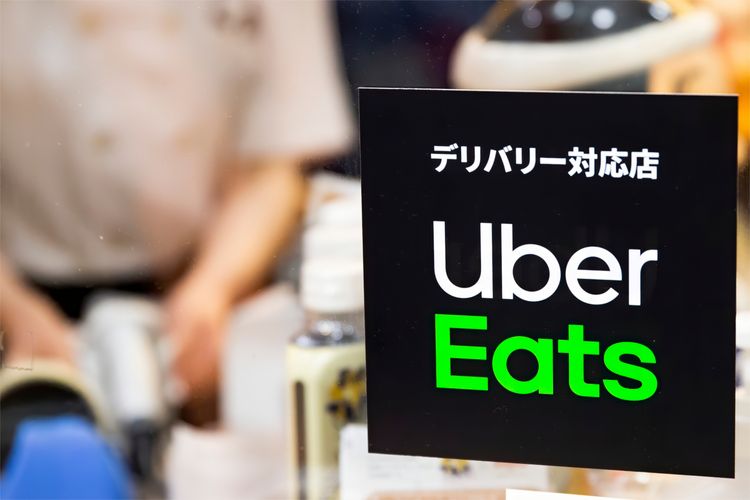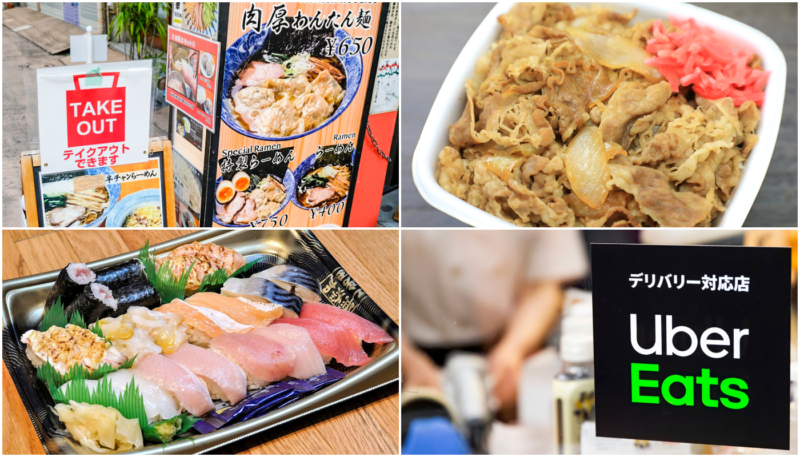Japan offers plenty of amazing things to see, but even more to eat! However, life and work can often get in the way of exploring its delicious cuisine. Luckily, from curry to ramen, there are many takeout options available in Japan. In this article, we’ll dive into Japan’s takeout culture and explain just how exactly you can navigate the world of Japanese takeout so that you can enjoy and explore Japan’s cuisine in the most efficient way possible!
Can You Even Get Takeout in Japan?

In order to answer this question, it’s important to first clarify the definition of “takeout.”
If you mean taking leftovers at a restaurant to go, then no, you usually cannot do that in Japan. One of the reasons why is because unlike countries like the USA and Australia, portions at restaurants in Japan are just big enough for one person. There is no expectation that customers will want to bring leftovers back home with them, so many restaurants are not prepared to cater to this kind of request. Additionally, under Japanese law, restaurants can be held liable for any instances of food poisoning caused by their food, even if it occurs inside customers’ homes. For this reason, many eateries will not allow customers to take their leftovers back home with them.
However, if you mean ordering food delivery or going to a restaurant and buying takeout, then you’re in luck! There’s plenty of that in Japan, with the number of takeout options expected to increase in the future due to the hike in consumption tax back in October 2019 for eating in (8% → 10%) as well as the recent pandemic. We’ve detailed the different takeout options you can get in Japan below!
What Kind of Food Can You Get As Takeout in Japan?
While Japan does have your typical Western takeout food offerings such as pizza, it also offers some unique takeout options that you might not see elsewhere. Here are a couple of the ones that we’ve spotted.
Japanese Curry

Although this dish is not originally Japanese, the country has taken this Indian dish and made it their own. Much thicker than the Indian variety, Japanese curry is usually served on rice, but sometimes you can also find it slathered on top of other filling ingredients such as thick udon noodles.
When served as takeout, you’ll often notice that the curry is served separately from the rice, as pictured above. Not only does this ensure that the rice stays nice and fluffy, but it also allows you the freedom of eating the rice, curry, and toppings however you want. Pickles, which are often eaten together with Japanese curry, are usually sectioned off as well. Sometimes you’ll even find the sides, such as the shrimp tempura shown in the picture, served separately to retain their texture and flavor!
Big curry chains like Go! Go! Curry! or CoCo Ichibanya are the most likely to offer food delivery and/or takeout, but that doesn’t mean you can’t try ordering takeout from a small, local shop. If you’re craving curry, please try ordering some takeout!
Japanese Ramen

Yes! You can actually get ramen to go! There are two main avenues for getting ramen as takeout in Japan: order through food delivery services like Uber Eats or check individual stores to see if they offer takeout options.
If you do order from an individual store that has their own delivery service, keep in mind that takeout may be limited to local residents. In these cases, it usually signifies that the ramen will be delivered in ceramic bowls that the staff will pick up later. Just leave the bowls out in front of your door when you’re done!

In most other cases, ramen will be delivered to you in plastic or styrofoam containers. The soup will normally be separated from the rest of the ingredients to prevent them from getting soggy. You might also see ramen delivered in plastic baggies like the picture above*. This is another way that restaurants ensure that the ingredients stay as fresh as possible. Simply assemble everything together and you’ve got yourself a bowl of piping hot ramen!
* The picture above is of tsukemen, not ramen, and it involves heating the dipping soup before eating. Regardless, the concept is roughly the same with takeout ramen.
Donburi Rice Bowls

Donburi is a classic Japanese dish of meat, vegetables, and/or seafood served over rice. There are a hundred different donburi varieties in Japan, and thousands restaurants that serve some form of donburi. As donburi is typically quick to cook, it is considered a type of Japanese fast food, so you will find many restaurants offering it as a takeout option.
Similar to Japanese curry, many restaurants in Japan will keep the rice separated from the toppings in order to keep the fluffy texture and delicious taste of the white rice. You can choose to combine them or eat them separately, treating the toppings like a side dish!
One of the most popular types of donburi is gyudon/gyumeshi, or beef over rice. Japan has three main gyudon chains: Yoshinoya, Matsuya, and Sukiya. Not only are they all famous for their low prices and delicious gyudon, but every single one of them offers takeout for most of their menu. If you’re wondering where to try donburi takeout, check out any of these restaurants!
Bento Boxes

When it comes to takeout food in Japan, the Japanese bento box rules supreme. For many people, a ride on the shinkansen would not be complete without a boxed bento lunch consisting of rice and pretty much anything else that you can imagine: vegetables, steak, chicken, fish, etc.
Of course, that’s not to suggest that you can only get bento boxes at train stations. Many restaurants offer reasonably-priced bento box sets for both lunch and dinner in their takeout menus, and you can also purchase them from convenience stores and supermarkets. There are even chain stores that sell nothing but bento boxes, such as Hotto Motto and Origin Bento.
Bento boxes can almost be considered an integral part of Japanese culture and history, so do give them a try!
Sushi and Sashimi

Sushi and sashimi are two other incredibly popular takeout options in Japan. They’re often priced far more reasonably than what you would expect, and they’re an acceptable substitute for proper restaurants when you really want sushi but just can’t find the time or energy to go to a store.
While you can certainly buy takeout sushi from supermarkets and even convenience stores, our suggestion for ultimate freshness is to order from a sushi restaurant’s takeout menu, as you’ll have far more options to choose from. Not all restaurants offer takeout, but most of the larger chains do, such as the famous conveyor-belt sushi restaurant Sushiro.
How to Order Takeout From Restaurants in Japan

First of all, there are two ways to say “takeout” in Japanese: (o)mochikaeri (お持ち帰り) and teikuauto (テイクアウト), the second one being a loan word from English. You can go with either one, but Japanese signs will usually use the former to identify a takeout window where you can order food to go or to tell passersby that they offer takeout. You might also find the word takuhai (宅配), which shows that they run a food delivery service.
If the restaurant has none of the above plastered on their shop front, you can still walk in and ask, “Takeout OK?” In Japanese, this translates to “O-mochikaeri dekimasu ka?” Fast food restaurants are a lot easier as they will usually ask you at the beginning whether you’ll be dining in (Tennai de meshiagarimasu ka?) or ordering to go.
Where You Can Get Takeout in Japan
Local Restaurants

Apart from walking around to check for restaurants with the signs that we’ve discussed above, Google Maps is another great way to discover restaurants that do takeout in your area. Simply search for “takeout” to quickly check which places near you offer takeout. Not every restaurant will be listed online, though, so if you speak Japanese, give them a call and inquire if they offer their food to go. If you do not speak Japanese, then visit the restaurant in person and use the phrases in the earlier section.
Food Delivery Services

Even if you don’t have the energy or time to visit a restaurant, you can still bring restaurant food to you with a food delivery service. Although Japan has several available, most of them are in Japanese. Some popular English options are Uber Eats or Maishoku, the latter of which lets you choose from over 300 Tokyo restaurants. Using food delivery services can arguably be the easiest way to order takeout, as you can search by the type of food you’re looking for and your budget, so do give it a try if you really feel the need for takeout. Just note that coverage is often limited outside of large cities.
Convenience Stores

Japanese convenience stores carry all sorts of takeout food: hot and cold, fried or fresh, prepackaged or made at the store. You can get onigiri (rice balls), ready-to-eat salads, and cold cuts to make an impromptu meal, or you can order from the hot food area usually found near the registers, typically serving things like fries, chicken, croquettes, etc. If you’re in the mood for a bigger meal, grab one of their bento boxes and use the convenience store’s microwave or hot water dispenser to prepare it on the spot.
Don’t know what the staff at the convenience store are saying? Here are the top 12 phrases you ought to know for any convenience store visit in Japan.
Family Restaurants

Japanese family restaurants are known for being cheap and quick, but what few know is that many of them have takeout menus! Though their takeout options are usually a little pricier than if you were to eat in store, it might be well worth it if you have an aversion to busy or noisy places. Family restaurants also allow you to try all types of international fare that have been adjusted to suit the Japanese palate. Saizeriya, for example, has Italian food, while you can find Chinese and Western options at Jonathan’s and Gusto.
You can read more about Japan’s family restaurants here.
Department Stores

Another option for takeout is department stores! Large department stores such as Takashimaya and Seibu have at least one floor with a variety of foods, ranging from Japanese sweets to pickled vegetables, meat, bento boxes, and more. Usually, this area gets busy once people start coming home from work (around 7:00 – 9:00 pm), so make sure to get there early. On the other hand, if you get there about an hour before the department store closes, you can pick up a lot of great food for 20-50% off!
Try Eating Some Japanese Takeout!
With so many takeout options available in Japan, it would be almost remiss to not try even one! In the process, you might even be able to gain greater control over your schedule. So, why not order some takeout during your next trip to Japan?
If you want to give feedback on any of our articles, you have an idea that you’d really like to see come to life, or you just have a question on Japan, hit us up on our Facebook!
The information in this article is accurate at the time of publication.

